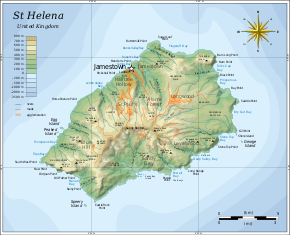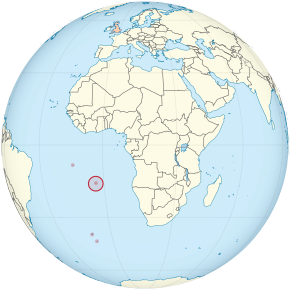
Back Saint Helena ACE Sint Helena Afrikaans St. Helena (Insel) ALS ሴይንት ህሊና ደሴት Amharic Isla Santa Helena AN Sancte Elene Īeg ANG سانت هيلينا Arabic سانت هيلينا ARZ Islla Santa Lena AST Müqəddəs Yelena adası Azerbaijani
Saint Helena | |
|---|---|
| Motto: "Loyal and Unshakable" | |
| Anthem: "God Save the King" | |
| Unofficial anthem: "My Saint Helena Island" | |
 Map of Saint Helena | |
 Location of Saint Helena in the southern Atlantic Ocean | |
| Sovereign state | |
| Colonial charter | 1657 |
| Crown colony | 22 April 1834[1] |
| Current constitution | 1 September 2009 |
| Capital | Jamestown 15°56′S 05°43′W / 15.933°S 5.717°W |
| Largest city | Half Tree Hollow 15°56′0″S 5°43′12″W / 15.93333°S 5.72000°W |
| Official languages | English |
| Demonym(s) |
|
| Government | Devolved parliamentary dependency under a constitutional monarchy |
• Monarch | Charles III |
• Governor | Nigel Phillips |
| Julie Thomas | |
| Legislature | Legislative Council |
| Government of the United Kingdom | |
• Minister | Vacant |
| Area | |
• Total | 121.8 km2 (47.0 sq mi) |
| Highest elevation | 820 m (2,690 ft) |
| Population | |
• 2021 census | 4,439[2] |
• Density | 36.5/km2 (94.5/sq mi) |
| Currency | Pound sterling Saint Helena pound (£) (SHP) |
| Time zone | UTC±00:00 (GMT) |
| Driving side | left |
| Calling code | +290 |
| Internet TLD | .sh |
Saint Helena (/ˌsɛnt (h)ɪˈliːnə, ˌsɪnt-, sənt-/, US: /ˌseɪnt-/[3][4]) is one of the three constituent parts of Saint Helena, Ascension and Tristan da Cunha,[5] a remote British overseas territory. Saint Helena is a volcanic and tropical island, located in the South Atlantic Ocean, some 1,874 km (1,165 miles) west of mainland Africa, with Angola and Namibia being the closest nations, geographically. The island is located around 1,950 km (1,210 mi) west of the coast of southwestern South Africa, and 4,000 km (2,500 mi) east of Rio de Janeiro, Brazil. Until 2018, the primary method of reaching Saint Helena was by booking a spot on the RMS St Helena—a cargo and post delivery vessel that also ferried visitors—which routinely made the 3,141 km (1,951 mi), six-day journey from Cape Town, South Africa.
Saint Helena measures about 16 by 8 km (10 by 5 mi) and has a population of 4,439 per the 2021 census.[2] It was named after Helena, mother of Constantine I. It is one of the most remote major islands in the world and was uninhabited when discovered by the Portuguese enroute to the Indian subcontinent in 1502. For about four centuries, the island was an important stopover for ships from Europe to Asia and back, while sailing around the African continent, until the opening of the Suez Canal. Saint Helena is the United Kingdom's second-oldest overseas territory after Bermuda.
Saint Helena is known for being the site of Napoleon's second exile, following his final defeat in 1815.
- ^ Cite error: The named reference
crown colonywas invoked but never defined (see the help page). - ^ a b "St-Helena at a Glance" (PDF). St Helena Government. 18 November 2021. Retrieved 30 November 2021.
- ^ Jones, Daniel (2011). Roach, Peter; Setter, Jane; Esling, John (eds.). "St Helena". Cambridge English Pronouncing Dictionary (18th ed.). Cambridge University Press. ISBN 978-0-521-15255-6.
- ^ "Saint Helena". Merriam-Webster.com Dictionary. Retrieved 4 August 2023.
- ^ "Constitution of St. Helena, Ascension and Tristan da Cunha". UK Archives. 2009. Archived from the original on 12 March 2010. Retrieved 21 July 2012.
© MMXXIII Rich X Search. We shall prevail. All rights reserved. Rich X Search

